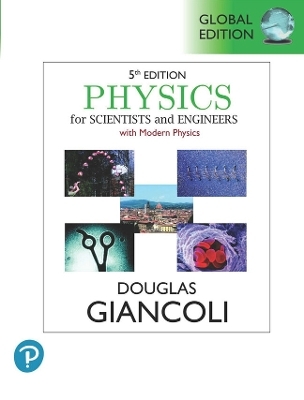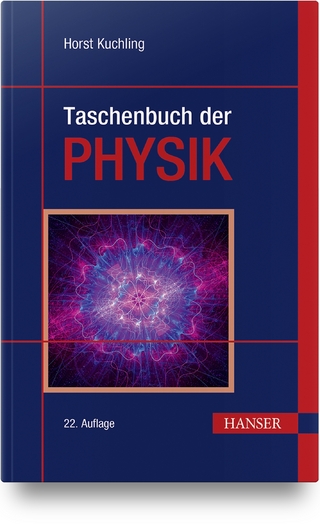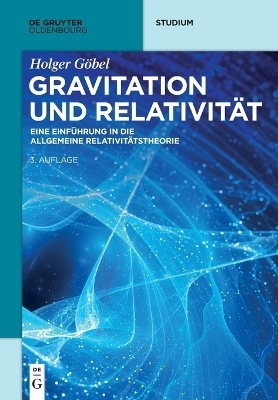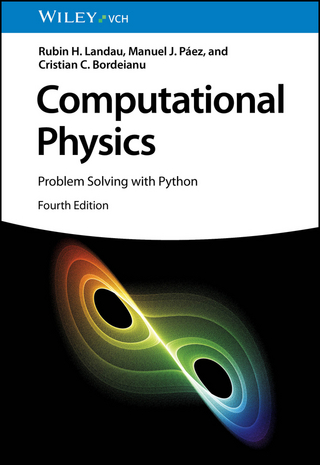
Physics for Scientists & Engineers with Modern Physics, Global Edition
Pearson Education Limited (Verlag)
978-1-292-44027-9 (ISBN)
Precise. Highly accurate. Carefully crafted.
Physics for Scientists and Engineers combines outstanding pedagogy and a clear and direct narrative with applications that draw the student into the physics at hand. The text gives students a thorough understanding of the basic concepts of physics in all its aspects, from mechanics to modern physics. Each topic begins with concrete observations and experiences that students can relate to their everyday lives and future professions, and then moves to generalizations and the more formal aspects of the physics to show why we believe what we believe. The 5th Edition presents a wide range of new applications including the physics of digital, added approaches for practical problem-solving techniques, and new Mastering Physics resources that enhance the understanding of physics.
Douglas C. Giancoli obtained his BA in physics (summa cum laude) from UC Berkeley, his MS in physics at MIT, and his PhD in elementary particle physics back at UC Berkeley. He spent 2 years as a post-doctoral fellow at UC Berkeley's Virus lab developing skills in molecular biology and biophysics. His mentors include Nobel winners Emilio Segre and Donald Glaser. He has taught a wide range of undergraduate courses, traditional as well as innovative ones, and continues to update his textbooks meticulously, seeking ways to better provide an understanding of physics for students. Doug's favorite spare-time activity is the outdoors, especially climbing peaks. He says climbing peaks is like learning physics: it takes effort and the rewards are great.
Introduction, Measurement, Estimating
How Science Works
Models, Theories, and Laws
Measurement and Uncertainty; Significant Figures
Units, Standards, and the SI System
Converting Units
Order of Magnitude: Rapid Estimating
*Dimensions and Dimensional Analysis
Describing Motion: Kinematics in One Dimension
Reference Frames and Displacement
Average Velocity
Instantaneous Velocity
Acceleration
Motion at Constant Acceleration
Solving Problems
Freely Falling Objects
*Variable Acceleration; Integral Calculus
Kinematics in Two or Three Dimensions; Vectors
Vectors and Scalars
Addition of Vectors—Graphical Methods
Subtraction of Vectors, and Multiplication of a Vector by a Scalar
Adding Vectors by Components
Unit Vectors
Vector Kinematics
Solving Problems Involving Projectile Motion
Relative Velocity
Dynamics: Newton's Laws of Motion
Force
Newton's First Law of Motion
Mass
Newton's Second Law of Motion
Newton's Third Law of Motion
Weight—the Force of Gravity; and the Normal Force
Solving Problems with Newton's Laws: Free-Body Diagrams
Problem Solving—A General Approach
Using Newton's Laws: Friction, Circular Motion, Drag Forces
Using Newton's Laws with Friction
Uniform Circular Motion—Kinematics
Dynamics of Uniform Circular Motion
Highway Curves: Banked and Unbanked
Nonuniform Circular Motion
*Velocity-Dependent Forces: Drag and Terminal Velocity
Gravitation and Newton's Synthesis
Newton's Law of Universal Gravitation
Vector Form of Newton's Law of Universal Gravitation
Gravity Near the Earth's Surface
Satellites and "Weightlessness"
Planets, Kepler's Laws, and Newton's Synthesis
Moon Rises an Hour Later Each Day
Types of Forces in Nature
*Gravitational Field
*Principle of Equivalence; Curvature of Space; Black Holes
Work and Energy
Work Done by a Constant Force
Scalar Product of Two Vectors
Work Done by a Varying Force
Kinetic Energy and the Work-Energy Principle
Conservation of Energy
Conservative and Nonconservative Forces
Potential Energy
Mechanical Energy and Its Conservation
Problem Solving Using Conservation of Mechanical Energy
The Law of Conservation of Energy
Energy Conservation with Dissipative Forces: Solving Problems
Gravitational Potential Energy and Escape Velocity
Power
Potential Energy Diagrams; Stable and Unstable Equilibrium
*Gravitational Assist (Slingshot)
Linear Momentum
Momentum and Its Relation to Force
Conservation of Momentum
Collisions and Impulse
Conservation of Energy and Momentum in Collisions
Elastic Collisions in One Dimension
Inelastic Collisions
Collisions in 2 or 3 Dimensions
Center of Mass (cm)
Center of Mass and Translational Motion
*Systems of Variable Mass; Rocket Propulsion
Rotational Motion
Angular Quantities
Vector Nature of Angular Quantities
Constant Angular Acceleration
Torque
Rotational Dynamics; Torque and Rotational Inertia
Solving Problems in Rotational Dynamics
Determining Moments of Inertia
Rotational Kinetic Energy
Rotational plus Translational Motion; Rolling
*Why Does a Rolling Sphere Slow Down?
Angular Momentum; General Rotation
Angular Momentum — Objects Rotating About a Fixed Axis
Vector Cross Product; Torque as a Vector
Angular Momentum of a Particle
Angular Momentum and Torque for a System of Particles; General Motion
Angular Momentum and Torque for a Rigid Object
Conservation of Angular Momentum
*The Spinning Top and Gyroscope
Rotating Frames of Reference; Inertial Forces
*The Coriolis Effect
Static Equilibrium; Elasticity and Fracture
The Conditions for Equilibrium
Solving Statics Problems
*Applications to Muscles and Joints
Stability and Balance
Elasticity; Stress and Strain
Fracture
Trusses and Bridges
Arches and Domes
Fluids
Phases of Matter
Density and Specific Gravity
Pressure in Fluids
Atmospheric Pressure and Gauge Pressure
Pascal's Principle
Measurement of Pressure; Gauges and the Barometer
Buoyancy and Archimedes' Principle
Fluids in Motion; Flow Rate and the Equation of Continuity
Bernoulli's Equation
Applications of Bernoulli's Principle: Torricelli, Airplanes, Baseballs,Blood Flow
Viscosity
*Flow in Tubes: Poiseuille's Equation, Blood Flow
*Surface Tension and Capillarity
*Pumps, and the Heart
Oscillations
Oscillations of a Spring
Simple Harmonic Motion
Energy in the Simple Harmonic Oscillator
Simple Harmonic Motion Related to Uniform Circular Motion
The Simple Pendulum
*The Physical Pendulum and the Torsion Pendulum
Damped Harmonic Motion
Forced Oscillations; Resonance
Wave Motion
Characteristics of Wave Motion
Types of Waves: Transverse and Longitudinal
Energy Transported by Waves
Mathematical Representation of a Traveling Wave
*The Wave Equation
The Principle of Superposition
Reflection and Transmission
Interference
Standing Waves; Resonance
Refraction
Diffraction
Sound
Characteristics of Sound
Mathematical Representation of Longitudinal Waves
Intensity of Sound: Decibels
Sources of Sound: Vibrating Strings and Air Columns
*Quality of Sound, and Noise; Superposition
Interference of Sound Waves; Beats
Doppler Effect
*Shock Waves and the Sonic Boom
*Applications: Sonar, Ultrasound, and Medical Imaging
Temperature, Thermal Expansion, and the Ideal Gas Law
Atomic Theory of Matter
Temperature and Thermometers
Thermal Equilibrium and the Zeroth Law of Thermodynamics
Thermal Expansion
*Thermal Stresses
The Gas Laws and Absolute Temperature
The Ideal Gas Law
Problem Solving with the Ideal Gas Law
Ideal Gas Law in Terms of Molecules: Avogadro's Number
*Ideal Gas Temperature Scale—a Standard
Kinetic Theory of Gases
The Ideal Gas Law and the Molecular Interpretation of Temperature
Distribution of Molecular Speeds
Real Gases and Changes of Phase
Vapor Pressure and Humidity
Temperature of Water Decrease with Altitude
Van der Waals Equation of State
Mean Free Path
Diffusion
Heat and the First Law of Thermodynamics
Heat as Energy Transfer
Internal Energy
Specific Heat
Calorimetry— Solving Problems
Latent Heat
The First Law of Thermodynamics
Thermodynamic Processes and the First Law
Molar Specific Heats for Gases, and the Equipartition of Energy
Adiabatic Expansion of a Gas
Heat Transfer: Conduction, Convection, Radiation
Second Law of Thermodynamics
The Second Law of Thermodynamics— Introduction
Heat Engines
The Carnot Engine; Reversible and Irreversible Processes
Refrigerators, Air Conditioners, and Heat Pumps
Entropy
Entropy and the Second Law of Thermodynamics
Order to Disorder
Unavailability of Energy; Heat Death
Statistical Interpretation of Entropy and the Second Law
Thermodynamic Temperature; Third Law of Thermodynamics
*Thermal Pollution, Global Warming, and Energy Resources
Electric Charge and Electric Field
Static Electricity; Electric Charge and Its Conservation
Electric Charge in the Atom
Insulators and Conductors
Induced Charge; the Electroscope
Coulomb's Law
The Electric Field
Electric Field Calculations for Continuous Charge Distributions
Field Lines
Electric Fields and Conductors
Motion of a Charged Particle in an Electric Field
Electric Dipoles
*Electric Forces in Molecular Biology: DNA Structure and Replication
Gauss's Law
Electric Flux
Gauss's Law
Applications of Gauss's Law
*Experimental Basis of Gauss's and Coulomb's Laws
Electric Potential
Electric Potential Energy and Potential Difference
Relation between Electric Potential and Electric Field
Electric Potential Due to Point Charges
Potential Due to Any Charge Distribution
Equipotential Lines and Surfaces
Potential Due to Electric Dipole; Dipole Moment
E→Determined from V
Electrostatic Potential Energy; the Electron Volt
Digital; Binary Numbers; Signal Voltage
TV and Computer Monitors
Electrocardiogram (ECG or EKG)
Capacitance, Dielectrics, Electric Energy Storage
Capacitors
Determination of Capacitance
Capacitors in Series and Parallel
Storage of Electric Energy
Dielectrics
*Molecular Description of Dielectrics
Electric Current and Resistance
The Electric Battery
Electric Current
Ohm's Law: Resistance and Resistors
Resistivity
Electric Power
Power in Household Circuits
Alternating Current
Microscopic View of Electric Current
*Superconductivity
*Electrical Conduction in the Human Nervous System
DC Circuits
EMF and Terminal Voltage
Resistors in Series and in Parallel
Kirchhoff's Rules
EMFs in Series and in Parallel; Charging a Battery
RC Circuits — Resistor and Capacitor in Series
Electric Hazards and Safety
Ammeters and Voltmeters— Measurement Affects Quantity Measured
Magnetism
Magnets and Magnetic Fields
Electric Currents Produce Magnetic Fields
Force on an Electric Current in a Magnetic Field; Definition of B→
Force on an Electric Charge Moving in a Magnetic Field
Torque on a Current Loop; Magnetic Dipole Moment
Applications: Motors, Loudspeakers, Galvanometers
Discovery and Properties of the Electron
The Hall Effect
Mass Spectrometer
Sources of Magnetic Field
Magnetic Field Due to a Straight Wire
Force between Two Parallel Wires
Definitions of the Ampere and the Coulomb
Ampère's Law
Magnetic Field of a Solenoid and a Toroid
Biot-Savart Law
Magnetic Field Due to a Single Moving Charge
Magnetic Materials—Ferromagnetism
Electromagnets and Solenoids—Applications
Magnetic Fields in Magnetic Materials; Hysteresis
*Paramagnetism and Diamagnetism
Electromagnetic Induction and Faraday's Law
Induced EMF
Faraday's Law of Induction; Lenz's Law
EMF Induced in a Moving Conductor
Electric Generators
Back EMF and Counter Torque; Eddy Currents
Transformers and Transmission of Power
A Changing Magnetic Flux Produces an Electric Field
*Information Storage: Magnetic and Semiconductor
*Applications of Induction: Microphone, Seismograph, GFCI
Inductance, Electromagnetic Oscillations, and AC Circuits
Mutual Inductance
Self-Inductance; Inductors
Energy Stored in a Magnetic Field
LR Circuits
LC Circuits and Electromagnetic Oscillations
LC Oscillations with Resistance (LRC Circuit)
AC Circuits and Reactance
LRC Series AC Circuit; Phasor Diagrams
Resonance in AC Circuits
Impedance Matching
*Three-Phase AC
Maxwell's Equations and Electromagnetic Waves
Changing Electric Fields Produce Magnetic Fields; Displacement Current
Gauss's Law for Magnetism
Maxwell's Equations
Production of Electromagnetic Waves
Electromagnetic Waves, and Their Speed, Derived from Maxwell's Equations
Light as an Electromagnetic Wave and the Electromagnetic Spectrum
Measuring the Speed of Light
Energy in EM Waves; the Poynting Vector
Radiation Pressure
Radio and Television; Wireless Communication
Light: Reflection and Refraction
The Ray Model of Light
Reflection; Image Formation by a Plane Mirror
Formation of Images by Spherical Mirrors
Seeing Yourself in a Magnifying Mirror (Concave)
Convex (Rearview) Mirrors
Index of Refraction
Refraction: Snell's Law
The Visible Spectrum and Dispersion
Total Internal Reflection; Fiber Optics
*Refraction at a Spherical Surface
Lenses and Optical Instruments
Thin Lenses; Ray Tracing and Focal Length
The Thin Lens Equation
Combinations of Lenses
Lensmaker's Equation
Cameras: Film and Digital
The Human Eye; Corrective Lenses
Magnifying Glass
Compound Microscope
Aberrations of Lenses and Mirrors
The Wave Nature of Light: Interference and Polarization
Waves vs. Particles; Huygens' Principle and Diffraction
Huygens' Principle and the Law of Refraction
Interference-- Young's Double-Slit Experiment
Intensity in the Double-Slit Interference Pattern
Interference in Thin Films
Michelson Interferometer
Polarization
*Liquid Crystal Displays (LCD)
*Scattering of Light by the Atmosphere
Lumens, Luminous Flux, and Luminous Intensity
Efficiency of Lightbulbs
Diffraction
Diffraction by a Single Slit or Disk
Intensity in Single-Slit Diffraction Pattern
Diffraction in the Double-Slit Experiment
Interference vs. Diffraction
Limits of Resolution; Circular Apertures
Resolution of Telescopes and Microscopes; the λ Limit
Resolution of the Human Eye and Useful Magnification
Diffraction Grating
The Spectrometer and Spectroscopy
*Peak Widths and Resolving Power for a Diffraction Grating
X-Rays and X-Ray Diffraction
*X-Ray Imaging and Computed Tomography (CT Scan)
*Specialty Microscopes and Contrast
The Special Theory of Relativity
Galilean–Newtonian Relativity
The Michelson–Morley Experiment
Postulates of the Special Theory of Relativity
Simultaneity
Time Dilation and the Twin Paradox
Length Contraction
Four-Dimensional Space-Time
Galilean and Lorentz Transformations
Relativistic Momentum
The Ultimate Speed
E = mc²; Mass and Energy
Doppler Shift for Light
The Impact of Special Relativity
Early Quantum Theory and Models of the Atom
Blackbody Radiation; Planck's Quantum Hypothesis
Photon Theory of Light and the Photoelectric Effect
Energy, Mass, and Momentum of a Photon
Compton Effect
Photon Interactions; Pair Production
Wave-Particle Duality; the Principle of Complementarity
Wave Nature of Matter
Electron Microscopes
Early Models of the Atom
Atomic Spectra: Key to the Structure of the Atom
The Bohr Model
de Broglie's Hypothesis Applied to Atoms
Quantum Mechanics
Quantum Mechanics—A New Theory
The Wave Function and Its Interpretation; the Double-Slit Experiment
The Heisenberg Uncertainty Principle
Philosophic Implications; Probability Versus Determinism
The Schrödinger Equation in One Dimension-- Time-Independent Form
*Time-Dependent Schrödinger Equation
Free Particles; Plane Waves and Wave Packets
Particle in an Infinitely Deep Square Well Potential (a Rigid Box)
Finite Potential Well
Tunneling through a Barrier
Quantum Mechanics of Atoms
Quantum-Mechanical View of Atoms
Hydrogen Atom: Schrödinger Equation and Quantum Numbers
Hydrogen Atom Wave Functions
Multielectron Atoms; the Exclusion Principle
Periodic Table of Elements
X-Ray Spectra and Atomic Number
*Magnetic Dipole Moment; Total Angular Momentum
Fluorescence and Phosphorescence
Lasers
*Holography
Molecules and Solids
Bonding in Molecules
Potential-Energy Diagrams for Molecules
Weak (van der Waals) Bonds
Molecular Spectra
Bonding in Solids
Free-Electron Theory of Metals; Fermi Energy
Band Theory of Solids
Semiconductors and Doping
Semiconductor Diodes, LEDs, OLEDs
Transistors: Bipolar and MOSFETs
Integrated Circuits, 14-nm Technology
Nuclear Physics and Radioactivity
Structure and Properties of the Nucleus
Binding Energy and Nuclear Forces
Radioactivity
Alpha Decay
Beta Decay
Gamma Decay
Conservation of Nucleon Number and Other Conservation Laws
Half-Life and Rate of Decay
Decay Series
Radioactive Dating
Detection of Particles
Nuclear Energy; Effects and Uses of Radiation
Nuclear Reactions and the Transmutation of Elements
Cross Section
Nuclear Fission; Nuclear Reactors
Nuclear Fusion
Passage of Radiation Through Matter; Biological Damage
Measurement of Radiation Dosimetry
*Radiation Therapy
*Tracers in Research and Medicine
*Emission Tomography: PET and SPECT
*Nuclear Magnetic Resonance (NMR); Magnetic Resonance Imaging (MRI)
Elementary Particles
High-Energy Particles and Accelerators
Beginnings of Elementary Particle Physics—Particle Exchange
Particles and Antiparticles
Particle Interactions and Conservation Laws
Neutrinos
Particle Classification
Particle Stability and Resonances
Strangeness? Charm? Towards a New Model
Quarks
The Standard Model: QCD and Electroweak Theory
Grand Unified Theories
Strings and Supersymmetry
Astrophysics and Cosmology
Stars and Galaxies
Stellar Evolution: Birth and Death of Stars, Nucleosynthesis
Distance Measurements
General Relativity: Gravity and the Curvature of Space
The Expanding Universe: Redshift and Hubble's Law
The Big Bang and the Cosmic Microwave Background
The Standard Cosmological Model: Early History of the Universe
Inflation: Explaining Flatness, Uniformity, and Structure
Dark Matter and Dark Energy
Large-Scale Structure of the Universe
Gravitational Waves—LIGO
Finally . . .
Appendices
A. Mathematical Formulas
B. Derivatives and Integrals
C. Numerical Integration
D. More on Dimensional Analysis
E. Gravitational Force Due to a Spherical Mass Distribution
F. Differential Form of Maxwell's Equations
G. Selected Isotopes
| Erscheinungsdatum | 25.07.2022 |
|---|---|
| Verlagsort | Harlow |
| Sprache | englisch |
| Maße | 220 x 280 mm |
| Gewicht | 3024 g |
| Themenwelt | Naturwissenschaften ► Physik / Astronomie |
| ISBN-10 | 1-292-44027-9 / 1292440279 |
| ISBN-13 | 978-1-292-44027-9 / 9781292440279 |
| Zustand | Neuware |
| Informationen gemäß Produktsicherheitsverordnung (GPSR) | |
| Haben Sie eine Frage zum Produkt? |
aus dem Bereich


